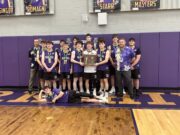Often in nature we talk about phenology, the annual cycle of events that occur year after year on an annual basis, bird migration is one of the most spectacular of these events. One of the best descriptors of migration has been defined by Keith Bildstein , a noted ornithologist. Migration- the seasonal, directed movements organisms undertake while traveling back and forth between their “breeding grounds” and their “wintering area” – occurs in almost all forms of life, plant and animal, large and small, and most of what is in between.
Migration patterns in birds have evolved over millennia, responding to seasonal shifts in the amount of light, temperature and especially food available to them. Most get the urge to migrate as conditions deteriorate within their environment. Some birds only migrate 20 miles while others migrate 20,000. To prepare for migration, birds become hyperphagic. This process is similar to animals as they prepare for hibernation. The increase in food consumption is stored as fat for the long journey ahead. Some birds do not migrate and remain year round. There are several species that we are familiar with: downy woodpeckers, red-bellied woodpeckers, tufted titmouse, white breasted nuthatch, and cardinals. There are three important concepts in understanding the migratory patterns of most birds; breeding range, year-round range, and winter range. These concepts are self explanatory and there can be some overlap of the ranges depending on the species. There are three types of migration patterns: Complete, Partial, and Irruptive. We are most familiar with birds whose migration pattern is complete. This pattern occurs when all birds of a species leave a range; shorebirds, tanagers, warblers, orioles, hummingbirds and most hawks of North America are some examples. The wintering range for most complete migrants from North America is South and Central America, the Caribbean basin, and the southernmost United States. Most birds move in a north – south direction; however there are a few who move from an east – west direction, moving between Manitoba and Saskatchewan and the Eastern seaboard. By far the most common type of migration is partial where most birds of a species leave a particular range. Partial migration is characterized by seasonal movements from the breeding ranges to their winter ranges. Robins are a great example. Most people see Robins year-round, but they are not the same Robins. The ones that live here in the summer migrate to middle states, while the Robins from Canada migrate here. Irruptive migrations are not seasonal or predictive. This type of migration usually occurs when sudden declines in food source occurs or with a temporary change in the environment and most of the species leave their range. Snowy owls, evening grosbeaks, red poles and crossbills are common examples we see during the winter months coming down from Canada.
Birds don’t have AAA or Google Maps, but they do have “flyways”. North America is divided into four different flyways that look like big funnels directing the birds south. They called the Atlantic, the Mississippi, the Central and the Pacific Flyways. Except along the coasts, the flyway boundaries are not always sharply defined, both in the northern breeding and the southern wintering ranges. As a matter of fact, in the region of Panama, parts of all four flyways merge into one. Northeast Ohio sits in the Atlantic Flyway.
Most birds won’t set any speed records while migrating. The smallest birds fly the slowest anywhere between 10-30 mph, while waterfowl fly the fastest, 28-50 mph. As the soaring birds use the thermal to gain altitude they fly very slowly around 10-15 mph. However as the move from thermal to thermal they can reach gliding speeds of up to 45 mph. The use of prevailing winds is very important to all migrants.
Throughout the migratory trip, birds must stop along the way to rest and refuel. They face the daunting challenge of flying over vast stretches of water, desert, and mountain ranges without stopping. They must deal with unfavorable weather patterns and manmade obstacles, not to mention the destruction of habitat. One of these obstacles is Lake Erie. Beginning in March, warblers make their way north to the boral forest in Canada. As they make their way north, the stop along the southern edge of the lake, particularly in the Sandusky area and Presque Island near Erie Pennsylvania. During the first few weeks in May they stop and refuel in these areas before making the journey across the lake. During this time the “Biggest week in American birding” takes place at McGee Marsh and surrounding area. People from all over the world come to see the spectacular diversity of warblers and other species. It is truly a sight to see.











